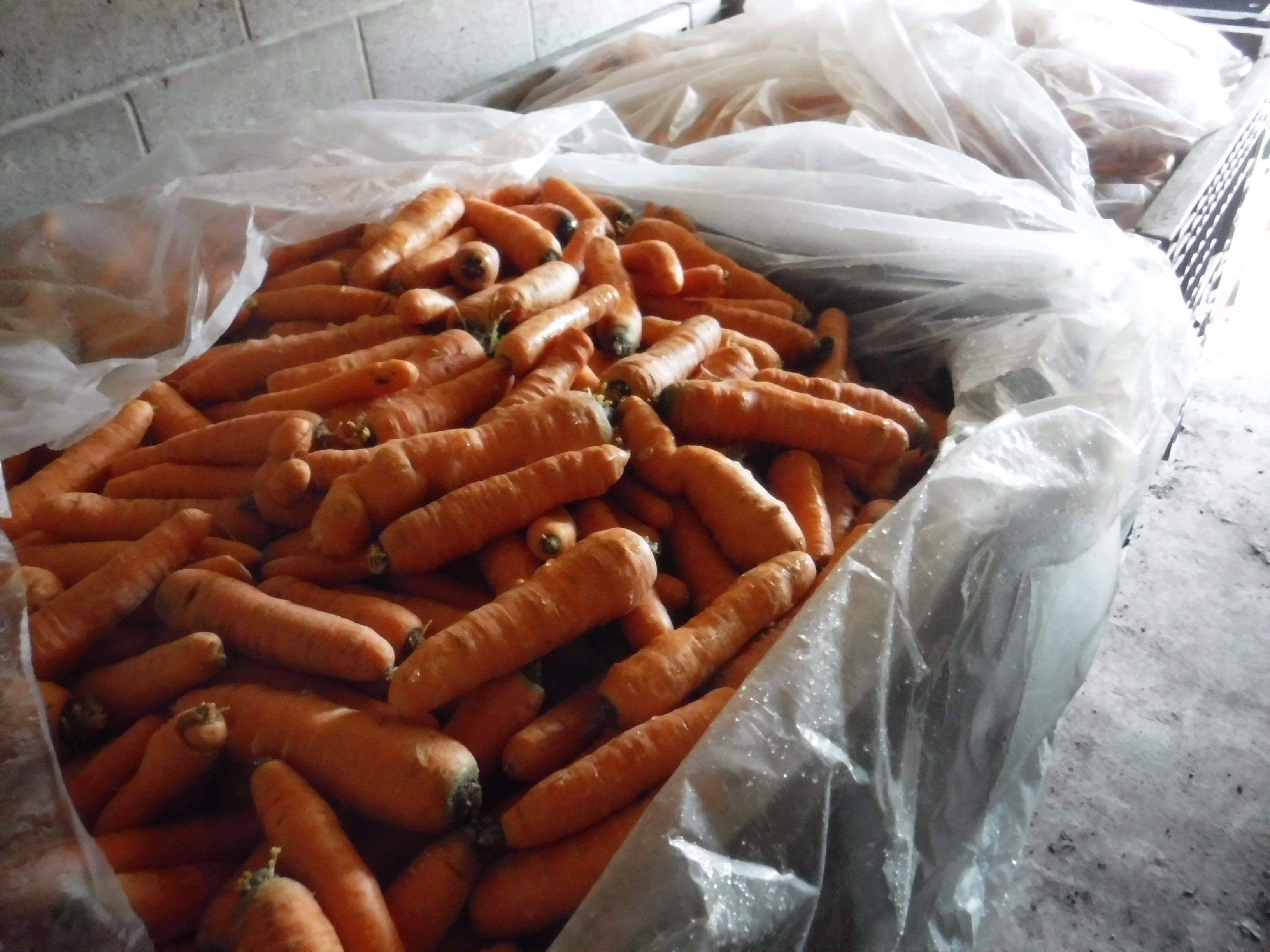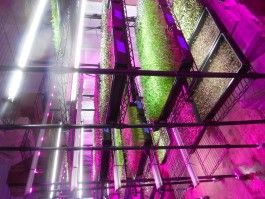Happy New Year! No doubt about it, 2020 will be a year we won't forget. Here at Great Oak Farm, 2020 will go down in the books as a pretty good production year overall. With no devastating rainfall events, disease pressure in the crops was refreshingly low, which really helped us hit our production goals. Also we managed to knock out 3 big infrastructure improvements. In addition to finishing our walk in cooler and erecting another large hoophouse, we managed to finish ONE MORE project by the year's end: our microgreen production room is up and running! Here's a picture of some microgreen pea shoots.
In case they are new to you (they are new to me!), microgreens are essentially tender young seedlings harvested just before or at the time the plant develops it's first true leaves. They have been used for some time now in upscale restaurants as pretty, edible garnishes for fancy dishes, but their true usefulness goes way beyond adding interesting colors and textures to a dish. What drew my attention to microgreen production first and foremost was incredibly high nutritional density.
Generally speaking, most microgreens have MANY times higher nutrient density than their mature vegetable counterparts. Red cabbage microgreens for example have been found to contain 6 times higher vitamin C than mature red cabbage, and a whopping 260 times more beta carotene than mature cabbage leaves! They also contain lutein (another important carotene) in higher concentrations than mature spinach, a crop considered to be rich in lutein. Vitamin E in red cabbage micros was a staggering 40 times higher than the in mature red cabbage! And the list goes on and on - pretty impressive. We all know how important it is to eat vegetables, and we all know we don't eat enough of them. Microgreens are a super convenient addition to any meal, as a fresh side like a salad, or even just on a burger. Just rinse and serve - it doesn't get much easier than that. Like healthy fast food. And a little bit goes a long way towards improving our diet and health. Microgreens are a great source of fresh veggie nutrition, especially in our deep, cold, and long winters here in the Northwoods. Just working in that grow room where it's warm, bright, and full of living plants oh so good for the soul. I can't wait to start regularly eating some!
(The above data is quoted from a study in the Journal of Agriculture and Food Chemistry, Assessment of Vitamin and Carotenoid Concentrations of Emerging Food Products: Edible Microgreens
by Zhenlei Xiao,† Gene E. Lester,*,‡ Yaguang Luo,‡ and Qin Wang*,
Department of Nutrition and Food Science, University of Maryland, College Park, Maryland 20742, United States. Look it up if you want to read more about the high nutrient density in microgreens!)
Above is a picture of some of the red cabbage micros we are growing now (gorgeous red stems, and tasty mild flavor!) We're also growing sweet pea micros (they actually taste like fresh sugar snap peas!), spicy radish micros, nutty sunflower micros, and even basil and cilantro micros sure to pack a punch of flavor in a tiny package. So far on this first grow out, the peas and cabbage micros will definitely be ready to make their way into your CSA boxes next week, and we'll have a few clamshells of sunflower and radish as well, though they were slower growers than I had anticipated. Basil and cilantro have proven to be very slow growing and definitely won't be ready in time, but I will try to have some ready for the mid January delivery.
Finishing the grow room was quite an accomplishment - I have been dreaming of getting steel siding in that space for several years now. The room we are growing the micros in is actually our squash storage room. Finding alternate uses for that room for the 9 months it is not full of squash has been on my short list, and micros were a perfect fit. Putting up steel on the ceiling (by myself!) was the hardest part of the project, so I had to use a little farmer ingenuity to figure that puzzle out. Thankfully, the pallet jack and last of the winter squash were handy to hold those sheets up while I screwed them into place.
While it's a cozy 74 degrees in the micro room, it's cold outside. Last week it was time to "break out the chains." No, I am not talking football yard maker chains... Those of us who drive old 2 wheel-drive tractors have to put chains on our tires for traction. It's amazing how well those fat tractor tires work on soil to keep you moving through mud and more, but once the ground freezes up they tend to slip and slide without chains to grip the icy ground. Each set of chains weighs more than I do, and heaving them up and over the tires is no joke. Now that they are on, they'll stay on until spring thaw thankfully. Unfortunately, right after I got the chains on, the tractor starter went out, so hopefully we don't get too much more snow before my new starter arrives next week!
In the hoophouse, here's a peek at what your spinach looks like for next week. All tucked in with heavy row cover to keep it protected from cold night-time temps. Depending on how warm this winter stays, this week may be the last big spinach harvest until March, so enjoy those sweet leaves of goodness while you can.
Finally, a few logistics. The plus item this week will be cheese from Fred and family at Happy Hollow creamery.
Also, I'd like to share a note from our Bayfield Foods Coop chairperson Farmer Brian from Northcroft Farm regarding the survey we sent out, some thoughts on the 2021 summer CSA season, and a few recipes to whet your appetite.
Thank you to everyone who responded to our recent customer survey. While no one likes filling out surveys the results are important for us in making improvements to our CSA. Based on the survey results I would like to tell you about some of the plans we have for the coming year.
One of the top comments was a lack of raspberries in the fruit shares. Unfortunately, a couple years ago, a new pest showed up called the spotted wing drosophila fly which lays its eggs in ripening raspberries and blackberries fruits. There is no effective treatment for these flies and so we will not be including raspberries in the fruit shares for the foreseeable future. We will be working to increase the diversity of the fruit share next year with the addition of melons and table grapes.
Meat variety was also a point of concern for some people and I can confirm we have had some decrease in diversity in our meat options. Due to Covid-19 interruptions in the meat processing industry more animals are being processed at small and mid-sized processors and not at the large industry owned plants. While this is great for the family-owned processing plants processing dates now need to be made 18+ months in advance and processors have eliminated many of the time-consuming products like meatballs, jerky and snack sticks. We have done what we can to find new processing facilities but that is likely to be a challenge for at least the next year. On a brighter note, Heritage Acres is planning on producing more chicken as well as ducks next year.
Based on customer response we will be switching to a digital newsletter with less frequent paper copies. To balance the loss of the paper newsletter we will be improving the farm happening and digital newsletter to include more recipes and information on what the upcoming weeks plus items will be.
We will also be working to increase our diversity of products next year. Starting in January Great Oak Farm will be offering microgreens and we have frozen a good supply of broccoli, cauliflower and blueberries which will be available this winter. On the docket for next summer are arugula, eggplant, hot peppers, mustard greens, and spaghetti squash. We are also working to develop some new value added products including a fermented salad dressing from Spirit Creek Farm.
The home delivery option was also a popular option this past year and we are going to be expanding that program in the coming year. In April and May we will be doing a repeat of last year with home delivery and a pick up option at Trinity Lutheran Church and the Chequamegon Food Coop. For the summer shares we will be expanding home delivery to Duluth/Superior on Thursdays.
Thank you again for your responses and Happy New Years!
Recipes from Farmer Brian's Kitchen
CAULIFLOWER CHOWDER
8 slices bacon chopped
1 smaller onion chopped
2 celery stalks chopped
2 garlic cloves minced
salt and pepper to taste
1.5# cauliflower thawed
1 large carrot chopped
1 medium potato chopped
½ cup water
2 tablespoons flour
2 cups chicken broth
2 cups milk
2 ½ cups shredded cheddar cheese
1) Chop bacon and cook in pan to make bacon crumbles to top the soup. 2) Use 2 tablespoons of bacon grease to sauté celery, garlic and onion. 3) Add chicken broth, ½ cup water, and 1.5# thawed cauliflower to the pot and puree with blender or submersion blender. 4) Add chopped potatoes and carrots and simmer until soft. 5) Add flour, milk, cheese, and salt and pepper to taste.
IDA’S UDON KIM CHI SALAD
1 package cooked Udon Noodles or Rice Noodles
1/4 C. Hijiki (seaweed)
1/2 C. Chopped Green Onions
½ to full pint of Kim Chi (depending on taste preferences)
Dressing:1/4 C. Sesame Oil
1/8 C. Rice Vinegar
Salt and Pepper to taste
Mix first 4 ingredients and then make dressing and add to noodle mix. Serve immediately or chill and serve later (best if taken out of the fridge for a little while before serving to soften noodles).Enjoy! Recipe from: Jennifer Sauter Sargent and Sarah York collaboration
That's it from the farm this week. Here's to a healthy and happy 2021!
In community,
Farmer Chris
Great Oak Farm










